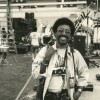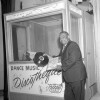Remembering Wattstax: A Celebration of Black Joy, Music, Healing and Community

"This is a beautiful day. It is a new day. It is a day of Black awareness." These words uttered by Jesse Jackson rang out at the Los Angeles Coliseum, August 20, 1972. It is a powerful invocation of Black pride that ended with Jackson calling on all the 100,000-something people among the crowds to affirm, "I am somebody... I am Black, beautiful, proud. I must be respected. I must be protected."
Just seven years after the Watts Uprising, Wattstax was a celebration of what is beautiful in the community. It was also a "publicity stunt," photographer Bruce Talamon tells KCET. Wattstax began when Stax L.A. office head and Watts native Forest Hamilton suggested the Memphis music label Stax Records fund a benefit concert for Watts while also providing additional exposure for their artists. Tickets cost just a $1 (or 99 cents) and attracted a crowd, dressed up and ready to enjoy themselves, with R&B, soul and funk artists like Isaac Hayes, the Staple Singers, the Bar-Kays, Kim Weston and more.
Talamon, now a noted R&B and funk photographer, was there that day, 50 years ago and shares what that day was like and how it changed the course of his career.
At the time, he had just graduated from college and was beginning to discover his path in life. He had yet to photograph "R&B, soul and funk royalty" like Michael Jackson, Diana Ross, Donna Summer and more. Now, with a couple of books, including a Taschen tome dedicated to his photographs from 1972 to 1982, and a yearlong exhibition at the Rock & Roll Hall of Fame, Talamon looks back and reflects on the spirit of Wattstax and what it means to be one of the few photographers who have readily available material that captured the momentous occasion. "I know who the photographers were on that stage that day," said Talamon, "And I know that photographs exist, but some of the stuff got lost." Excess photographs were thrown out, basements containing precious archives flooded, record companies changed hands. There was once a visual record, but as time and technology marches on, its physical traces seem to be fading and it becomes even more urgent to remember. Wattstax was "a model for what we now call 'artivism,'" says historian Dr. Daniel Walker, "In the same sense that Public Enemy, Billie Holiday, Stevie Wonder, J. Cole and others have used their art to make a real statement about rights and humanity, Wattstax gives it to you in buckets!"



